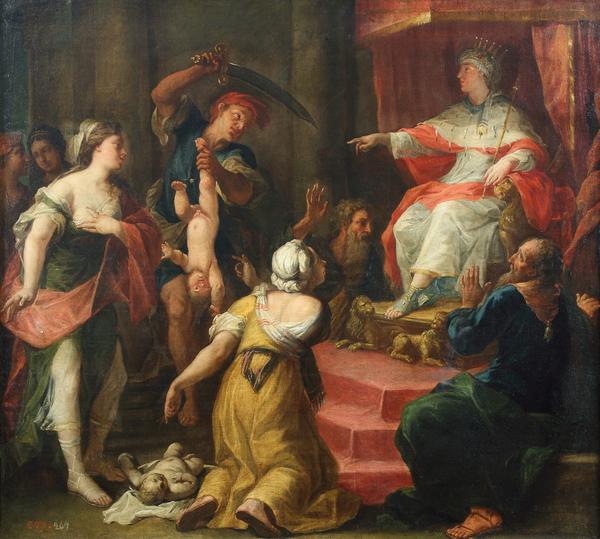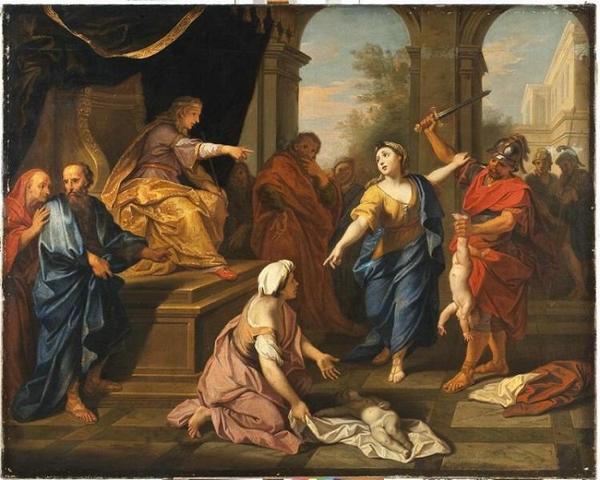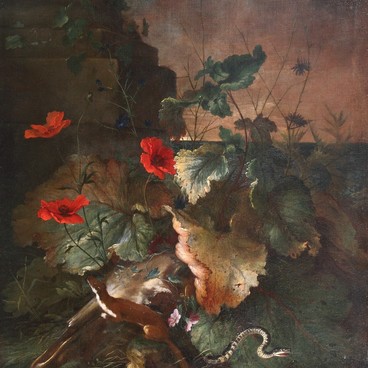Solomon’s Judgement was painted by an unknown artist in the first half of the 18th century. He depicted the turning point of the trial: the king’s servant is about to cut the child in two. Solomon was not actually going to have the baby killed, he just made such a cruel judgement to see the women’s reaction.
Solomon’s Judgement
Creation period
1st half of the 18th century
Dimensions
83x95,5 cm
Technique
canvas, oil
Collection
Exhibition
15
Open in app#1

Unknown author
Solomon’s Judgement
#2
#3
It is believed that Solomon lived in the 10th century BC. He was King of Israel, famous for his wisdom. According to a legend, once in his dream he heard God’s voice saying, Tell me what I should give you. Solomon asked for wisdom to rule the people fairly. God granted his selfless wish, so Solomon became the wisest of all kings.
#4
One day, two women and a baby were brought to him for trial. Both were mothers, they shared a dwelling and had given birth to sons, one three days earlier than the other. At night, one of the babies died. One woman claimed that her housemate had replaced the baby and had taken the living one for herself. The other denied that. There were no witnesses, so it seemed impossible to find the truth. King Solomon ordered to bring a sword and cut the living child in halves between the mothers. When she heard that, one woman begged that the child should be given to the other woman rather than be killed. The other didn’t mind the verdict: Neither I nor you shall have him. Cut him in two, she said. The people immediately realised which of them was cheating. Solomon ordered to give the baby to the woman who asked to save the boy’s life.
#5
In the scene, the unknown artist depicted the peak of emotions but painted the characters’ faces relatively calm.
#6
He retold the story by means of expressive gestures and poses: the men are theatrically raising their hands, one of the women presses her hand to her heart, the other dramatically points to her adversary and the dead child. The artist literally spinned a vortex of human figures, converging at the image of the living child. Such dramatism and strongly expressive gestures were typical of Baroque. Experts presume that the unknown artist came from the Venetian School whose followers stuck to that artistic style until the 1770’s.
#7
The story of Solomon’s judgement was popular in painting. For instance, Louis de Boulogne the Younger painted a picture on the same subject in the early 18th century:
#8
Louis Boulogne Jr. The court of Solomon. 1710. The Pushkin Museum.
#9
The Russian artists who drew on the same subject include Nikolai Ge and Konstantin Flavitsky.
#10
Yaroslavl Museum of Fine Arts
read morehide
00:00
00:00
1x
Solomon’s Judgement
Creation period
1st half of the 18th century
Dimensions
83x95,5 cm
Technique
canvas, oil
Collection
Exhibition
15
Open in app
Share



